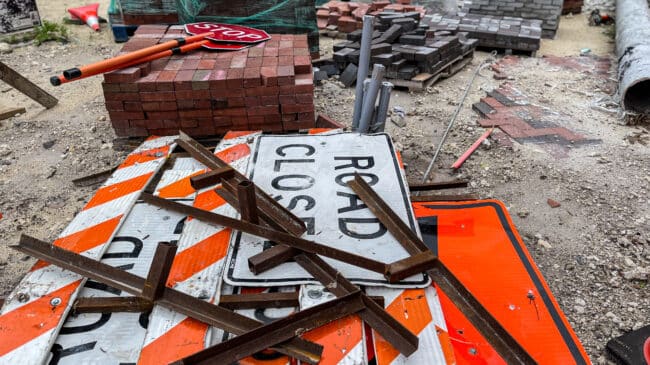Florida Gov. Ron DeSantis recently signed a bill that will allow the Florida Department of Transportation to study the use of phosphogypsum in road construction. This came after a longstanding federal-level prohibition on using phosphogypsum, which was repealed by then-President Donald Trump’s Environmental Protection Agency (EPA) in October 2020 and then reinstated by President Joe Biden’s EPA in June 2021. While phosphogypsum could improve roadway quality at a lower cost, its use should be subject to review and further study.
Phosphorus is a critical component of modern, industrial-grade fertilizers. Phosphogypsum remains after phosphate rocks are dissolved and treated to make phosphoric acid for use in fertilizer. The process produces nearly five tons of phosphogypsum for every ton of phosphoric acid. Florida accounts for 80% of the current phosphorus capacity in the country, per the EPA. As a result, Florida has an abundance of phosphogypsum.
This is an environmental concern because phosphate ores and phosphogypsum may contain significant quantities of radioactive metals. If improperly managed, these metals and their decay products can leach into aquifers and contaminate local water supplies.
Today’s disposal method for these byproducts leaves much to be desired. Currently, the wastewater remaining from the chemical process is collected in special dump sites termed gypsum stacks or “gypstacks.” These stacks aren’t a foolproof storage method. When the stacks fail, they pose environmental and health threats.
In 2009, a sinkhole opened under a dump site in White Springs, Florida. In 2021, phosphogypsum leached through the lining of the stack requiring excess wastewater to be dumped in Tampa Bay. The only means of storing phosphogypsum has a history of failing (or nearly failing), and alternative uses for phosphogypsum are heavily restricted.
However, it is possible to lower the risks associated with phosphogypsum to enable safe use in specific applications. A study originally published in the journal Heliyon examined how phosphogypsum can be used in roadways. While a few approaches can be taken to both strengthen phosphogypsum as a building component and lower the level of dangerous elements in it, ultimately, the chemical composition of phosphogypsum can vary based on geography. As such, there is no guaranteed one-size-fits-all approach for purification and pretreatment, and methods should be tailored to the specific chemical composition of any sample of phosphogypsum.
That said, these pretreatment methods could enable safe and efficient phosphogypsum use for various projects, such as roadways. If phosphogypsum is allowed in road construction, that would present a feasible way to reduce the size of the gypstacks in the state and the contamination risks associated with them. Because phosphogypsum is a waste product, it is relatively low cost, but it does have potential use as a supplementary material in the concrete slurry used to build roads.
A 1989 study from the University of Miami compared three roads constructed in Florida before the EPA’s ban on phosphogypsum in road construction. It found that Parrish Road, located in Polk County, constructed with phosphogypsum, had a cost per mile of $59,170 (in today’s dollars). This was much lower than the costs of Windy Hill Road and Tanner Road, also in Polk County, which cost $325,819 per mile and $247,713 per mile, respectively. The study also measured the environmental impact of the road and its construction. It determined that construction of the roadways posed “no measurable impact on the ambient groundwater.” Gamma radiation, which is extremely hazardous to life at high levels, was found to be within the normal range of the naturally occurring background radiation dose on the roadways. In addition, the study found “no significant changes” to radon exposure due to phosphogypsum use in the roadway.
A more recent 2019 study by the Fertilizer Institute, a national organization representing fertilizer producers, wholesalers and retailers, which has a vested interest in a repeal of the phosphogypsum construction ban, found equally promising results. The Fertilizer Institute’s study found that those involved in the construction and future users of a phosphogypsum-built roadway would not be exposed to any radiation levels above the EPA’s safety range.
The Heliyon study likewise found that “applying [phosphogypsum] to road materials can significantly increase the reuse and consumption of [phosphogypsum] and reduce [phosphogypsum] stockpiles.” The authors noted that using phosphogypsum would require purification to avoid letting the more radioactive elements and heavy metal impurities lower its strength as a building material and keep it safe for construction workers and road users. The study also stressed phosphogypsum’s durability as a building material. Still, it ends by calling for more research into techniques to scale up purification processes to make use of phosphogypsum both safe and economically viable.
As it stands, Florida’s law may have little impact due to the EPA’s prohibition on the use of phosphogypsum. Further, Florida has failed to request a waiver for any specific demonstration projects. The EPA insists that Florida’s law cannot deviate from federal requirements and that the state would still need to apply for approval.
Setting aside Florida’s legislation and EPA’s current regulations, additional studies are needed to examine phosphogypsum’s role in road construction. Current research suggests using phosphogypsum in roadway construction benefits the environment and taxpayers. However, further research can help clarify the safety and environmental impacts of its use. Pursuant to Florida’s new law, the state should establish some test scenarios for demonstration and submit them for EPA approval.

